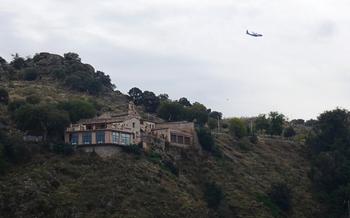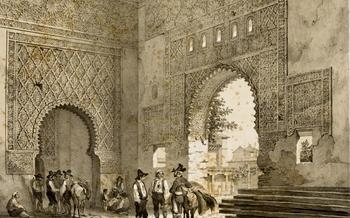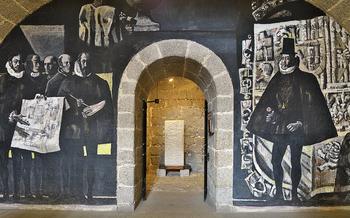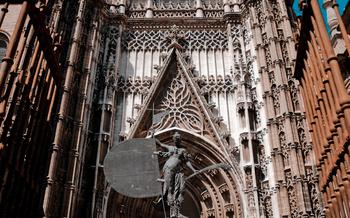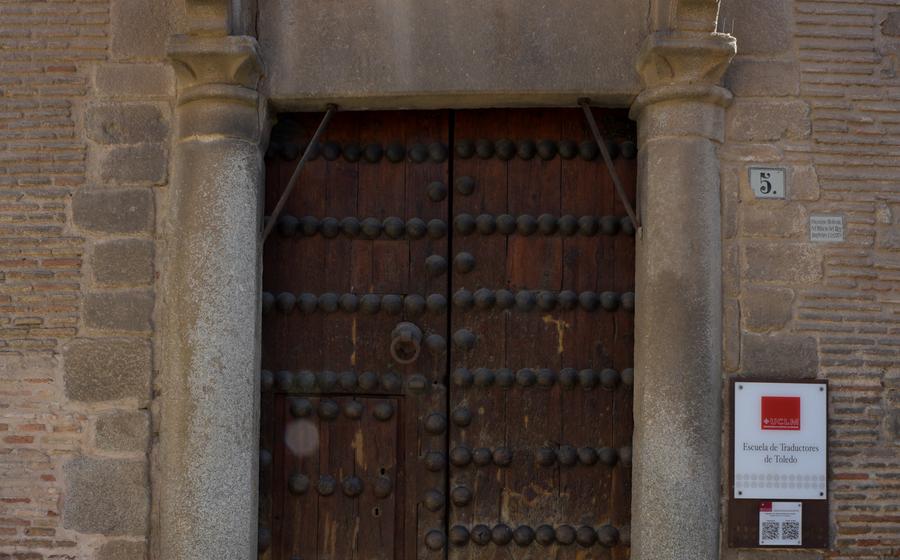
The Palace of Pedro I
- Historical Significance:
- Architecture and Design:
- Must-See Rooms
- Gardens and Courtyard
- Museum Collections
- Guided Tours
- Events and Exhibitions
- Accessibility and Facilities
- Photography and Videography:
- Souvenirs and Shopping
- Dress Code and Etiquette
- Nearby Attractions:
- Getting There and Transportation:
- Hours of Operation and Admission Fees
- Insider Tip:
Historical Significance:
The Palace of Pedro I, also known as the Alcázar of Toledo, holds a significant place in Spanish history. Built in the 14th century by King Pedro I of Castile, it served as a royal residence for centuries, witnessing the reigns of powerful monarchs and playing a crucial role in shaping the city's destiny. Over time, the palace underwent several transformations, reflecting the evolving architectural styles and tastes of its successive occupants. Today, it stands as a testament to Toledo's rich heritage and its enduring legacy as the former capital of Spain. The palace's strategic location atop a hill overlooking the Tagus River further underscores its symbolic importance as a seat of power and authority, commanding a majestic presence over the city it has watched over for centuries.
Architecture and Design:
The Palace of Pedro I, also known as the Alcázar of Toledo, stands as a testament to the architectural prowess of its time. Its exterior, adorned with intricate Mudejar-style brickwork and fortified walls, exudes an aura of strength and grandeur. The palace's facade, with its elegant horseshoe arches and decorative tilework, hints at the splendor that awaits within.
Stepping inside, visitors are greeted by a spacious and awe-inspiring interior. The grand halls, with their soaring ceilings and intricate chandeliers, showcase the palace's opulence. The courtyards, with their lush gardens and fountains, offer a tranquil respite from the bustling city outside.
The palace's layout is a testament to its functionality as a royal residence. The living quarters, with their private chambers and luxurious amenities, provided a comfortable and private space for the king and his family. The Throne Room, with its elaborate decorations and imposing throne, symbolized the power and authority of the monarchy.
Throughout the palace, visitors can admire unique architectural features and decorative elements. The Hall of Mirrors, with its stunning collection of mirrors, creates an illusion of endless space and reflects the grandeur of the palace's interior. The Royal Chapel, with its intricate stained-glass windows and ornate altar, showcases the religious significance of the palace.
Must-See Rooms
Among the many grand chambers within the Palace of Pedro I, three stand out as must-see attractions for visitors. The Throne Room, with its opulent decor and imposing throne, exudes an aura of regal power. Intricate carvings, shimmering tapestries, and a magnificent chandelier create a breathtaking spectacle, transporting visitors back to a time of royal splendor.
The Hall of Mirrors, named for its stunning collection of mirrors that reflect and amplify the room's grandeur, is another highlight. The mirrored walls and intricately painted ceiling create an illusion of infinite space, while the gleaming chandeliers cast a warm glow upon the room's polished marble floors. The Hall of Mirrors served as a grand reception hall, where King Pedro I would host lavish banquets and entertain distinguished guests.
Finally, the Royal Chapel, a testament to the palace's religious significance, is a masterpiece of Gothic architecture. The chapel's soaring vaulted ceilings, intricate stained glass windows, and ornate altar create a serene and sacred atmosphere. Visitors can admire the exquisite craftsmanship of the altarpieces, depicting scenes from the life of Christ, and marvel at the delicate carvings that adorn the choir stalls.
Gardens and Courtyard
The Alcázar of Toledo boasts lush gardens that offer a serene retreat from the bustling city. These verdant spaces, meticulously manicured and adorned with vibrant flowers, provide a tranquil oasis for visitors to relax and soak in the beauty of their surroundings. The central courtyard, the heart of the gardens, is a testament to the palace's architectural splendor. Its intricate tilework, graceful fountains, and delicate arches create a picturesque setting that transports visitors back in time.
Strolling through the gardens, one can admire the vibrant blooms of roses, lilies, and jasmine, which fill the air with their intoxicating fragrance. The carefully designed paths lead visitors through shaded groves and sunny meadows, offering glimpses of the palace's majestic facade from various angles. The gardens also feature secluded nooks and benches where visitors can sit and savor the tranquility of the surroundings, immersing themselves in the palace's rich history and beauty.
Museum Collections
The Palace of Pedro I houses a fascinating museum that showcases a treasure trove of artifacts, providing a glimpse into the palace's rich history and the lives of its former occupants. The museum's collection spans centuries, encompassing a diverse range of objects that tell the story of the palace's evolution and its significance as a royal residence.
One of the highlights of the museum is its collection of furniture, which includes intricate pieces from various periods, each reflecting the changing tastes and styles of the palace's inhabitants. Visitors can admire elaborate beds, ornate chairs, and finely carved tables that once graced the palace's grand halls and private chambers.
The museum also boasts an impressive collection of paintings, featuring works by renowned Spanish artists, including El Greco and Goya. These masterpieces depict historical events, religious scenes, and portraits of the royal family, offering visitors a glimpse into the artistic and cultural landscape of Toledo during the palace's heyday.
In addition, the museum houses a collection of tapestries, which were once used to adorn the palace's walls. These exquisite textiles, woven with intricate designs and vibrant colors, showcase the artistry and craftsmanship of the era. Visitors can admire scenes from mythology, history, and nature, woven into these beautiful tapestries.
These collections collectively provide a fascinating journey through time, allowing visitors to immerse themselves in the history and culture of the Palace of Pedro I. Whether you're an art enthusiast, a history buff, or simply curious about the lives of royalty, the museum offers a wealth of treasures to explore and appreciate.
Guided Tours
Guided tours are highly recommended for visitors seeking an immersive and informative experience at the Palace of Pedro I. These tours provide an in-depth look into the palace's history, architecture, and significance, offering insights and anecdotes that bring the palace to life.
Various tour options are available to cater to different interests and preferences. General admission tours offer a comprehensive overview of the palace, including its main halls, courtyards, and gardens. Thematic tours focus on specific aspects of the palace's history or architecture, such as the role of King Pedro I or the evolution of the palace's design. VIP experiences offer exclusive access to restricted areas, personalized attention from expert guides, and unique insights into the palace's secrets.
To get the most out of your guided tour, book in advance to secure your spot, especially during peak tourist season. Check the palace's website or contact the visitor center for tour schedules and availability. Arrive a few minutes early to ensure you don't miss the start of your tour.
Follow the guide's instructions and stay with the group to ensure you don't get lost or miss any important information. Feel free to ask questions and engage in discussions with your guide to enhance your understanding of the palace's history and significance.
Events and Exhibitions
The Palace of Pedro I is not just a historical monument but also a vibrant cultural hub that hosts a variety of events and exhibitions throughout the year. These events bring the palace to life, offering visitors a chance to experience its grandeur and opulence in new and exciting ways.
Special concerts, art shows, and cultural performances are regularly held in the palace's grand halls and courtyards. These events showcase the work of talented local and international artists, providing an immersive and unforgettable experience for visitors. From classical music concerts to contemporary art exhibitions, there is something for everyone at the Palace of Pedro I.
To find out about upcoming events and plan your visit accordingly, check the palace's official website or social media pages. Advance booking is recommended for popular events to avoid disappointment. Whether you're a history buff, an art enthusiast, or simply looking for a unique and memorable experience, the events and exhibitions at the Palace of Pedro I are not to be missed.
Accessibility and Facilities
The Alcázar of Toledo is committed to providing an accessible and inclusive experience for all visitors. Wheelchair ramps and elevators are available throughout the palace, ensuring that all areas are accessible to visitors with limited mobility. Restrooms, cafes, and other visitor facilities are also accessible and designed to accommodate the needs of all guests.
For visitors with children, the palace offers a variety of amenities to ensure a comfortable and enjoyable visit. Strollers and baby carriers are welcome, and there are designated areas for diaper changing and breastfeeding. The palace also offers family-friendly tours and activities designed to engage and educate children of all ages.
To make the most of your visit with limited mobility or with children, it is recommended to plan ahead. Contact the palace in advance to inquire about any specific accessibility needs or requests. The staff is friendly and accommodating and will do their best to ensure that you have a positive and memorable experience.
Photography and Videography:
The Palace of Pedro I offers visitors the opportunity to capture stunning photographs and videos of its architectural beauty, intricate interiors, and picturesque gardens. While photography and videography are permitted in most areas of the palace, there are a few guidelines visitors should keep in mind.
-
Flash photography is not allowed inside the palace to protect the delicate artwork and artifacts from damage.
-
Tripods, monopods, and other camera support equipment are not permitted in the palace's interior spaces.
-
Video recording is allowed for personal use only. Commercial filming and photography require prior permission from the palace administration.
-
Drones are not permitted on the palace grounds due to safety and security concerns.
To capture the best shots, consider visiting the palace during the "golden hours" of sunrise or sunset when the natural light creates a warm and inviting glow. Take advantage of the palace's many vantage points, such as the rooftop terrace, to capture panoramic views of the city and the surrounding countryside.
For those interested in capturing unique perspectives, explore the palace's hidden corners and lesser-known spaces. The palace's gardens, with their lush greenery and vibrant flowers, offer a beautiful backdrop for photographs and videos.
By following these guidelines and using a bit of creativity, visitors can create lasting memories of their visit to the Palace of Pedro I.
Souvenirs and Shopping
The Palace of Pedro I offers a well-stocked gift shop where visitors can purchase a variety of souvenirs and mementos to remember their visit. From postcards and magnets featuring stunning images of the palace's architecture and gardens to replicas of historical artifacts and traditional Spanish handicrafts, there is something for every taste and budget.
For those looking for truly unique souvenirs, the shop offers a selection of items inspired by the palace's rich history and art. These include intricate jewelry pieces designed after the palace's decorative motifs, replicas of royal clothing and armor, and hand-painted ceramics reminiscent of those used in the palace during its heyday.
Whether you're looking for a small token to remind you of your visit or a special gift for a loved one, the Palace of Pedro I's gift shop is sure to have something to suit your needs. Be sure to take your time browsing the selection and choosing the perfect memento to cherish for years to come.
Dress Code and Etiquette
When visiting the Palace of Pedro I, it is important to be mindful of the palace's dress code and etiquette guidelines. Visitors should dress respectfully, avoiding revealing or overly casual clothing. Smart casual attire is generally recommended, with covered shoulders and knees.
It is also important to behave respectfully while visiting the palace. This includes refraining from touching or leaning against the exhibits, speaking loudly, or using flash photography. Visitors should be considerate of other visitors and palace staff, and follow any instructions or guidelines provided by the palace authorities.
By adhering to the dress code and etiquette guidelines, visitors can show respect for the palace's history and heritage, and ensure that everyone has a pleasant and enjoyable visit.
Nearby Attractions:
Toledo, a city steeped in history and culture, offers a wealth of attractions beyond the Palace of Pedro I. Just a short walk away, visitors can explore the magnificent Toledo Cathedral, a stunning example of Gothic architecture with its towering spires and intricate stained-glass windows. The city is also home to several other notable churches, including the Church of Santo Tomé, which houses El Greco's masterpiece, "The Burial of Count Orgaz."
For those interested in art and history, the Museo del Greco, dedicated to the life and works of the renowned painter, is a must-visit. The museum showcases a collection of El Greco's paintings, including "The View of Toledo," which captures the city's essence from a unique perspective.
Toledo is also famous for its medieval fortifications. Visitors can walk along the city walls, offering breathtaking panoramic views and a glimpse into Toledo's rich past.
Combine your visit to the Palace of Pedro I with these other attractions to create a comprehensive and unforgettable experience in Toledo.
Getting There and Transportation:
Reaching the Palace of Pedro I in Toledo is a breeze, with a range of transportation options available. Public transport is a convenient choice, with buses stopping right outside the palace gates. For those who prefer a more personalized experience, taxis are readily available and can drop you off at the palace entrance. Tour buses are an excellent option for visitors who want to combine their palace visit with other attractions in Toledo.
If you're driving, you'll find ample parking facilities near the palace. The parking lot at the Miradero del Valle is a popular choice, offering stunning views of the city. Alternatively, the underground parking at the Plaza del Ayuntamiento is conveniently located just a short walk from the palace.
To avoid traffic congestion, especially during peak tourist season, plan your visit outside of rush hours. The early morning or late afternoon are ideal times to visit, as you'll encounter fewer crowds and have the palace's grandeur all to yourself.
Hours of Operation and Admission Fees
The Palace of Pedro I is open to the public for visits from Tuesday to Sunday, with varying hours depending on the season. During the peak season from April to October, the palace is open from 10 am to 7 pm. In the off-season from November to March, the hours are slightly shorter, from 10 am to 5 pm. It remains closed on Mondays and major holidays.
Admission fees: - Adults: €10 - Children (6-12 years): €5 - Concessions (students, seniors): €8
To avoid long lines, particularly during peak tourist season, pre-purchasing tickets online is highly recommended. This allows you to skip the queues and secure your entry at a preferred time.
Insider Tip:
As you explore the palace, keep an eye out for the hidden gem known as the "Secret Garden." Tucked away behind a discreet door, this enchanting garden offers a tranquil retreat from the palace's grandeur. Stroll along its winding paths, admire the colorful blooms, and soak in the peaceful atmosphere. After your visit to the palace, indulge in an authentic Spanish dining experience at "El Fogón de Toledo," a charming restaurant just a short walk away. Savor the delectable local cuisine and immerse yourself in the vibrant atmosphere of this traditional Spanish establishment. To make your Toledo experience truly unforgettable, consider taking a guided tour of the city's ancient underground tunnels. Discover the hidden secrets that lie beneath the city's surface and gain a deeper appreciation for Toledo's rich history and culture.


